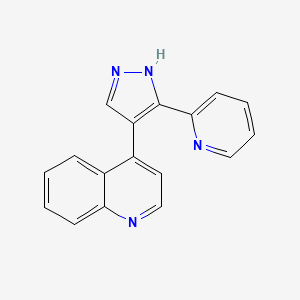
Lycorine
Overview
Description
Scientific Research Applications
Lycorine has a wide range of scientific research applications:
Mechanism of Action
Target of Action
Lycorine, a naturally active alkaloid, has been shown to have inhibitory effects on a variety of cancers . The primary targets of this compound in the treatment of glioblastoma (GBM) include 10 key target genes: AKT1, SRC, HSP90AA1, HRAS, MMP9, BCL2L1, IGF1, MAPK14, STAT1, and KDR . These genes play an important role in the therapeutic effect of this compound on GBM . In addition, this compound has been found to target the Wnt/β-catenin pathway in multiple myeloma stem cell-like cells .
Mode of Action
This compound interacts with its targets by docking to them, thereby inhibiting their activity . For instance, this compound has been found to inhibit the activation of PDGFRα by docking to it . It also attenuates the phosphorylation of PDGFRα . The molecular docking results showed that this compound had strong binding efficiency with the 10 key genes .
Biochemical Pathways
This compound acts on GBM by multiple pathways, including inducing apoptosis and reactive oxygen species production . Gene Ontology (GO) and Kyoto Encyclopedia of Genes and Genomes (KEGG) enrichment analysis showed that these pathways play a significant role in the action of this compound .
Result of Action
The use of this compound has been found to induce apoptosis in U-87 MG glioblastoma cells . It also inhibits the proliferation of myeloma cells from cell lines or patients, mainly through decreasing ALDH1+ cells . Moreover, this compound exhibits cytostatic effects by targeting the actin cytoskeleton rather than by inducing apoptosis in cancer cells .
Action Environment
The environmental conditions that influence this compound production are crucial to understand, as they can impact the compound’s action, efficacy, and stability . There isn’t much information about how the genes in the this compound biosynthesis pathway respond to different types of light in lycoris seedlings or how light quality affects this compound accumulation
Future Directions
Biochemical Analysis
Biochemical Properties
Lycorine interacts with various enzymes, proteins, and other biomolecules. It has been found to inhibit acetylcholinesterase and topoisomerase . The nature of these interactions contributes to its multiple biological functions and pharmacological effects .
Cellular Effects
This compound influences cell function by impacting cell signaling pathways, gene expression, and cellular metabolism . It has shown strong pharmacological effects on many diseases, including anti-leukemia, anti-tumor, anti-angiogenesis, anti-virus, anti-bacteria, anti-inflammation, and antimalaria .
Molecular Mechanism
This compound exerts its effects at the molecular level through binding interactions with biomolecules, enzyme inhibition or activation, and changes in gene expression . For instance, it has been found to have strong binding efficiency with key genes involved in glioblastoma multiforme (GBM), inducing apoptosis and reactive oxygen species production .
Temporal Effects in Laboratory Settings
Over time, this compound has shown stability and long-term effects on cellular function in both in vitro and in vivo studies . It has been produced sustainably in in vitro culture due to the pharmaceutical industries dramatically increasing demand for it .
Dosage Effects in Animal Models
The effects of this compound vary with different dosages in animal models . It exhibits numerous pharmacological effects on various diseases with very low toxicity and mild side effects .
Metabolic Pathways
This compound is involved in metabolic pathways formed by a coupling reaction of L-phenylalanine and L-tyrosine through intermediate o-methylnorbelladine—a common precursor of all Amaryllidaceae alkaloids .
Preparation Methods
Synthetic Routes and Reaction Conditions
Lycorine can be synthesized through several methods. One notable synthetic route involves the use of cyclopropyl acyliminium ion expansion and rearrangement, followed by a Diels-Alder reaction to construct the key diene intermediate . This method, developed by Boeckman et al., is considered one of the most elegant synthetic routes for this compound .
Industrial Production Methods
Industrial production of this compound typically involves extraction from plant sources. Air-dried powdered bulbs of plants like Sternbergia fischeriana are used to isolate this compound . Advanced techniques such as in vitro plant cell suspension cultures and bioreactors are also employed to produce this compound sustainably .
Chemical Reactions Analysis
Types of Reactions
Lycorine undergoes various chemical reactions, including oxidation, reduction, and substitution. It is known to inhibit protein synthesis and may inhibit ascorbic acid biosynthesis .
Common Reagents and Conditions
Common reagents used in this compound reactions include oxidizing agents for oxidation reactions and reducing agents for reduction reactions. Specific conditions vary depending on the desired reaction and product.
Major Products Formed
Major products formed from this compound reactions include derivatives with enhanced biological activities. For example, dihydrothis compound, generated through the hydrogenation of this compound, has been used clinically due to its better resistance against amebic dysentery and lower toxicity .
Comparison with Similar Compounds
Lycorine is unique among alkaloids due to its rigid ring skeleton and contiguous chiral centers . Similar compounds include:
Galanthamine: Used in the treatment of Alzheimer’s disease.
Lycoramine: Used for treating post-polio syndrome.
Dihydrothis compound: Used clinically for its lower toxicity and resistance against amebic dysentery.
These compounds share structural similarities with this compound but have distinct pharmacological properties and applications.
Properties
IUPAC Name |
(1S,17S,18S,19S)-5,7-dioxa-12-azapentacyclo[10.6.1.02,10.04,8.015,19]nonadeca-2,4(8),9,15-tetraene-17,18-diol | |
|---|---|---|
| Source | PubChem | |
| URL | https://pubchem.ncbi.nlm.nih.gov | |
| Description | Data deposited in or computed by PubChem | |
InChI |
InChI=1S/C16H17NO4/c18-11-3-8-1-2-17-6-9-4-12-13(21-7-20-12)5-10(9)14(15(8)17)16(11)19/h3-5,11,14-16,18-19H,1-2,6-7H2/t11-,14-,15+,16+/m0/s1 | |
| Source | PubChem | |
| URL | https://pubchem.ncbi.nlm.nih.gov | |
| Description | Data deposited in or computed by PubChem | |
InChI Key |
XGVJWXAYKUHDOO-DANNLKNASA-N | |
| Source | PubChem | |
| URL | https://pubchem.ncbi.nlm.nih.gov | |
| Description | Data deposited in or computed by PubChem | |
Canonical SMILES |
C1CN2CC3=CC4=C(C=C3C5C2C1=CC(C5O)O)OCO4 | |
| Source | PubChem | |
| URL | https://pubchem.ncbi.nlm.nih.gov | |
| Description | Data deposited in or computed by PubChem | |
Isomeric SMILES |
C1CN2CC3=CC4=C(C=C3[C@H]5[C@H]2C1=C[C@@H]([C@H]5O)O)OCO4 | |
| Source | PubChem | |
| URL | https://pubchem.ncbi.nlm.nih.gov | |
| Description | Data deposited in or computed by PubChem | |
Molecular Formula |
C16H17NO4 | |
| Source | PubChem | |
| URL | https://pubchem.ncbi.nlm.nih.gov | |
| Description | Data deposited in or computed by PubChem | |
DSSTOX Substance ID |
DTXSID60197208 | |
| Record name | Lycorine | |
| Source | EPA DSSTox | |
| URL | https://comptox.epa.gov/dashboard/DTXSID60197208 | |
| Description | DSSTox provides a high quality public chemistry resource for supporting improved predictive toxicology. | |
Molecular Weight |
287.31 g/mol | |
| Source | PubChem | |
| URL | https://pubchem.ncbi.nlm.nih.gov | |
| Description | Data deposited in or computed by PubChem | |
CAS No. |
476-28-8 | |
| Record name | Lycorine | |
| Source | CAS Common Chemistry | |
| URL | https://commonchemistry.cas.org/detail?cas_rn=476-28-8 | |
| Description | CAS Common Chemistry is an open community resource for accessing chemical information. Nearly 500,000 chemical substances from CAS REGISTRY cover areas of community interest, including common and frequently regulated chemicals, and those relevant to high school and undergraduate chemistry classes. This chemical information, curated by our expert scientists, is provided in alignment with our mission as a division of the American Chemical Society. | |
| Explanation | The data from CAS Common Chemistry is provided under a CC-BY-NC 4.0 license, unless otherwise stated. | |
| Record name | Lycorine | |
| Source | ChemIDplus | |
| URL | https://pubchem.ncbi.nlm.nih.gov/substance/?source=chemidplus&sourceid=0000476288 | |
| Description | ChemIDplus is a free, web search system that provides access to the structure and nomenclature authority files used for the identification of chemical substances cited in National Library of Medicine (NLM) databases, including the TOXNET system. | |
| Record name | lycorine | |
| Source | DTP/NCI | |
| URL | https://dtp.cancer.gov/dtpstandard/servlet/dwindex?searchtype=NSC&outputformat=html&searchlist=683873 | |
| Description | The NCI Development Therapeutics Program (DTP) provides services and resources to the academic and private-sector research communities worldwide to facilitate the discovery and development of new cancer therapeutic agents. | |
| Explanation | Unless otherwise indicated, all text within NCI products is free of copyright and may be reused without our permission. Credit the National Cancer Institute as the source. | |
| Record name | lycorine | |
| Source | DTP/NCI | |
| URL | https://dtp.cancer.gov/dtpstandard/servlet/dwindex?searchtype=NSC&outputformat=html&searchlist=401360 | |
| Description | The NCI Development Therapeutics Program (DTP) provides services and resources to the academic and private-sector research communities worldwide to facilitate the discovery and development of new cancer therapeutic agents. | |
| Explanation | Unless otherwise indicated, all text within NCI products is free of copyright and may be reused without our permission. Credit the National Cancer Institute as the source. | |
| Record name | Lycorine | |
| Source | EPA DSSTox | |
| URL | https://comptox.epa.gov/dashboard/DTXSID60197208 | |
| Description | DSSTox provides a high quality public chemistry resource for supporting improved predictive toxicology. | |
| Record name | Lycorine | |
| Source | European Chemicals Agency (ECHA) | |
| URL | https://echa.europa.eu/substance-information/-/substanceinfo/100.006.822 | |
| Description | The European Chemicals Agency (ECHA) is an agency of the European Union which is the driving force among regulatory authorities in implementing the EU's groundbreaking chemicals legislation for the benefit of human health and the environment as well as for innovation and competitiveness. | |
| Explanation | Use of the information, documents and data from the ECHA website is subject to the terms and conditions of this Legal Notice, and subject to other binding limitations provided for under applicable law, the information, documents and data made available on the ECHA website may be reproduced, distributed and/or used, totally or in part, for non-commercial purposes provided that ECHA is acknowledged as the source: "Source: European Chemicals Agency, http://echa.europa.eu/". Such acknowledgement must be included in each copy of the material. ECHA permits and encourages organisations and individuals to create links to the ECHA website under the following cumulative conditions: Links can only be made to webpages that provide a link to the Legal Notice page. | |
| Record name | LYCORINE | |
| Source | FDA Global Substance Registration System (GSRS) | |
| URL | https://gsrs.ncats.nih.gov/ginas/app/beta/substances/I9Q105R5BU | |
| Description | The FDA Global Substance Registration System (GSRS) enables the efficient and accurate exchange of information on what substances are in regulated products. Instead of relying on names, which vary across regulatory domains, countries, and regions, the GSRS knowledge base makes it possible for substances to be defined by standardized, scientific descriptions. | |
| Explanation | Unless otherwise noted, the contents of the FDA website (www.fda.gov), both text and graphics, are not copyrighted. They are in the public domain and may be republished, reprinted and otherwise used freely by anyone without the need to obtain permission from FDA. Credit to the U.S. Food and Drug Administration as the source is appreciated but not required. | |
Retrosynthesis Analysis
AI-Powered Synthesis Planning: Our tool employs the Template_relevance Pistachio, Template_relevance Bkms_metabolic, Template_relevance Pistachio_ringbreaker, Template_relevance Reaxys, Template_relevance Reaxys_biocatalysis model, leveraging a vast database of chemical reactions to predict feasible synthetic routes.
One-Step Synthesis Focus: Specifically designed for one-step synthesis, it provides concise and direct routes for your target compounds, streamlining the synthesis process.
Accurate Predictions: Utilizing the extensive PISTACHIO, BKMS_METABOLIC, PISTACHIO_RINGBREAKER, REAXYS, REAXYS_BIOCATALYSIS database, our tool offers high-accuracy predictions, reflecting the latest in chemical research and data.
Strategy Settings
| Precursor scoring | Relevance Heuristic |
|---|---|
| Min. plausibility | 0.01 |
| Model | Template_relevance |
| Template Set | Pistachio/Bkms_metabolic/Pistachio_ringbreaker/Reaxys/Reaxys_biocatalysis |
| Top-N result to add to graph | 6 |
Feasible Synthetic Routes
Disclaimer and Information on In-Vitro Research Products
Please be aware that all articles and product information presented on BenchChem are intended solely for informational purposes. The products available for purchase on BenchChem are specifically designed for in-vitro studies, which are conducted outside of living organisms. In-vitro studies, derived from the Latin term "in glass," involve experiments performed in controlled laboratory settings using cells or tissues. It is important to note that these products are not categorized as medicines or drugs, and they have not received approval from the FDA for the prevention, treatment, or cure of any medical condition, ailment, or disease. We must emphasize that any form of bodily introduction of these products into humans or animals is strictly prohibited by law. It is essential to adhere to these guidelines to ensure compliance with legal and ethical standards in research and experimentation.


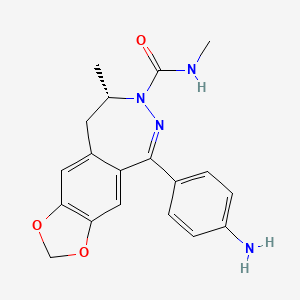
![(2S,4S)-4-(4-carboxyphenoxy)-1-[(2R)-2-[4-[(2-sulfobenzoyl)amino]imidazol-1-yl]octanoyl]pyrrolidine-2-carboxylic acid](/img/structure/B1675661.png)
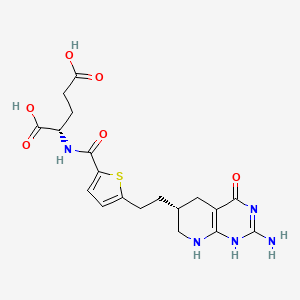
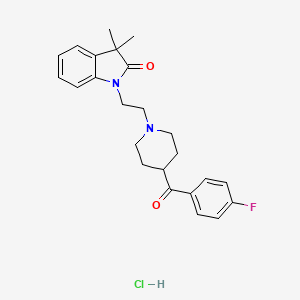
![(3-{[3-(2-Amino-2-Oxoethyl)-1-Benzyl-2-Ethyl-1h-Indol-5-Yl]oxy}propyl)phosphonic Acid](/img/structure/B1675666.png)
![2-[(E)-[4-[(4-acetyl-3-hydroxy-2-propylphenyl)methoxy]phenyl]methylideneamino]guanidine](/img/structure/B1675667.png)

![2-[(E)-[4-[(3-hydroxy-4-propanoyl-2-propylphenyl)methoxy]phenyl]methylideneamino]guanidine](/img/structure/B1675669.png)
![[(2R,3R)-1,1-dioxo-2-propan-2-ylthiolan-3-yl] N-[(2R,3R)-4-[(3aR,6S,7aS)-6-(tert-butylcarbamoyl)-3,3a,4,6,7,7a-hexahydro-2H-thieno[3,2-c]pyridin-5-yl]-3-hydroxy-1-phenylsulfanylbutan-2-yl]carbamate](/img/structure/B1675670.png)
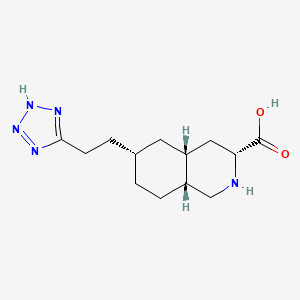
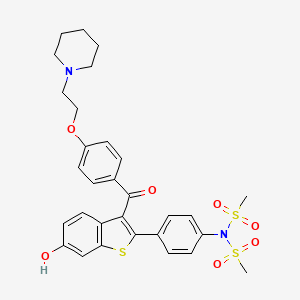
![2-[(E)-[3-[(4-benzoylphenyl)methoxy]phenyl]methylideneamino]guanidine](/img/structure/B1675674.png)
![4-fluoro-N-[3-(1-methylpiperidin-4-yl)-1H-indol-5-yl]benzamide;hydrochloride](/img/structure/B1675675.png)
